tow TOYOTA HIGHLANDER 2019 Owners Manual (in English)
[x] Cancel search | Manufacturer: TOYOTA, Model Year: 2019, Model line: HIGHLANDER, Model: TOYOTA HIGHLANDER 2019Pages: 732, PDF Size: 14.44 MB
Page 3 of 732
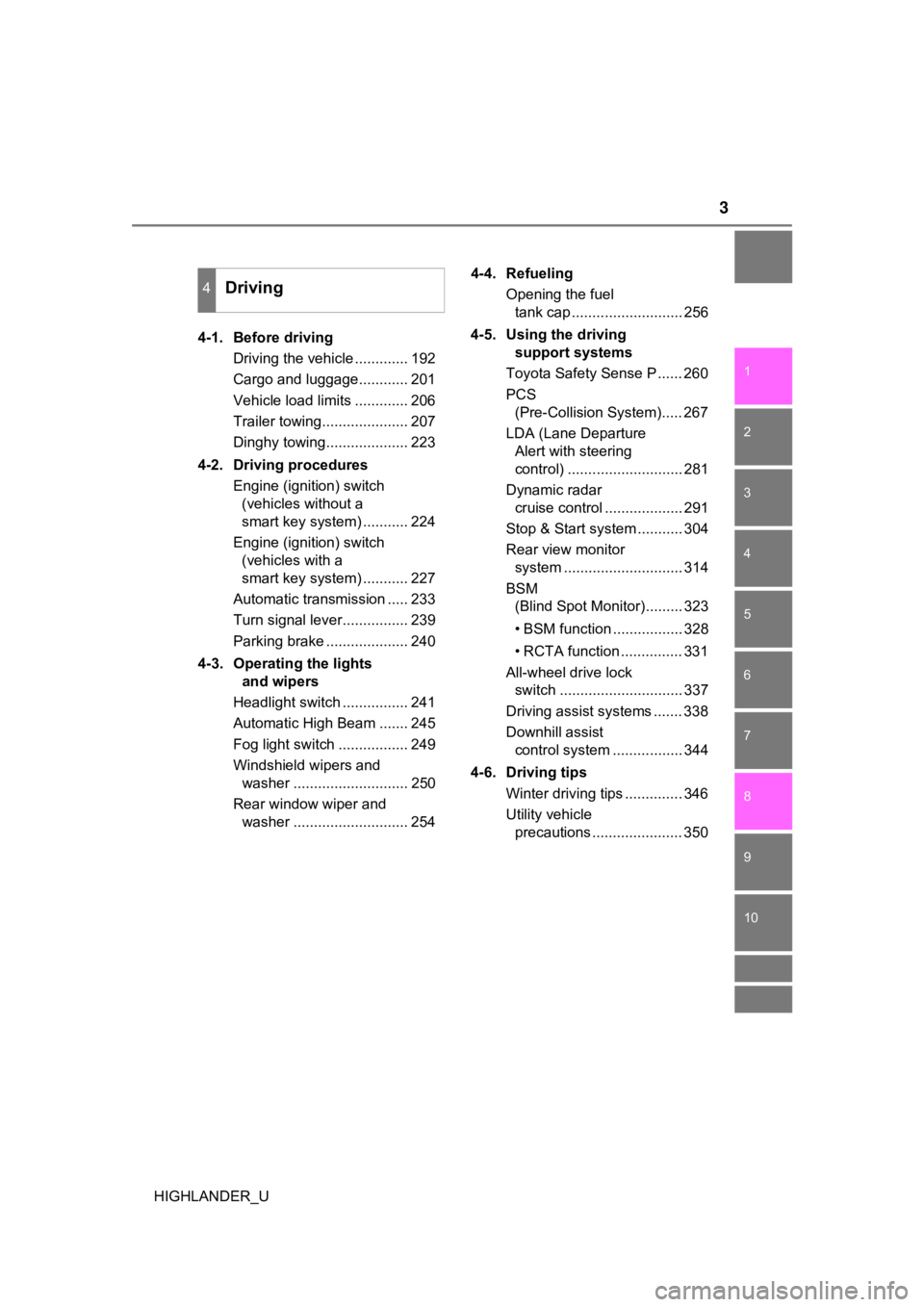
3
1
8 7
6
5
4
3
2
9
HIGHLANDER_U
10
4-1. Before drivingDriving the vehicle ............. 192
Cargo and luggage............ 201
Vehicle load limits ............. 206
Trailer towing..................... 207
Dinghy towing.................... 223
4-2. Driving procedures Engine (ignition) switch (vehicles without a
smart key system) ........... 224
Engine (ignition) switch (vehicles with a
smart key system) ........... 227
Automatic transmission ..... 233
Turn signal lever................ 239
Parking brake .................... 240
4-3. Operating the lights and wipers
Headlight switch ................ 241
Automatic High Beam ....... 245
Fog light switch ................. 249
Windshield wipers and washer ............................ 250
Rear window wiper and washer ............................ 254 4-4. Refueling
Opening the fuel tank cap ........................... 256
4-5. Using the driving support systems
Toyota Safety Sense P ...... 260
PCS (Pre-Collision System)..... 267
LDA (Lane Departure Alert with steering
control) ............................ 281
Dynamic radar cruise control ................... 291
Stop & Start system ........... 304
Rear view monitor system ............................. 314
BSM (Blind Spot Monitor)......... 323
• BSM function ................. 328
• RCTA function ............... 331
All-wheel drive lock switch .............................. 337
Driving assist systems ....... 338
Downhill assist control system ................. 344
4-6. Driving tips Winter driving tips .............. 346
Utility vehicle precautions ...................... 350
4Driving
Page 6 of 732

TABLE OF CONTENTS6
HIGHLANDER_U7-1. Maintenance and care
Cleaning and protecting the vehicle exterior .......... 502
Cleaning and protecting the vehicle interior ........... 506
7-2. Maintenance Maintenance requirements ................... 509
General maintenance ........ 512
Emission inspection and maintenance (I/M)
programs ......................... 515
7-3. Do-it-yourself maintenance
Do-it-yourself service precautions ..................... 516
Hood.................................. 518
Positioning a floor jack ...... 520
Engine compartment ......... 521
Tires .................................. 533
Tire inflation pressure........ 544
Wheels .............................. 547
Air conditioning filter .......... 549
Wireless remote control/ electronic key battery ...... 551
Checking and replacing fuses ................ 554
Light bulbs ......................... 558 8-1. Essential information
Emergency flashers ........... 574
If your vehicle has to be stopped in an
emergency....................... 575
8-2. Steps to take in an emergency
If your vehicle needs to be towed ...................... 577
If you think something is wrong ........................... 581
Fuel pump shut off system ............................. 582
If a warning light turns on or a warning buzzer
sounds ............................. 583
If a warning message is displayed...................... 593
If you have a flat tire .......... 610
If the engine will not start ................................. 635
If the electronic key does not operate
properly ........................... 637
If the vehicle battery is discharged ................... 640
If your vehicle overheats......................... 646
If the vehicle becomes stuck ................................ 649
7Maintenance and care8When trouble arises
Page 16 of 732
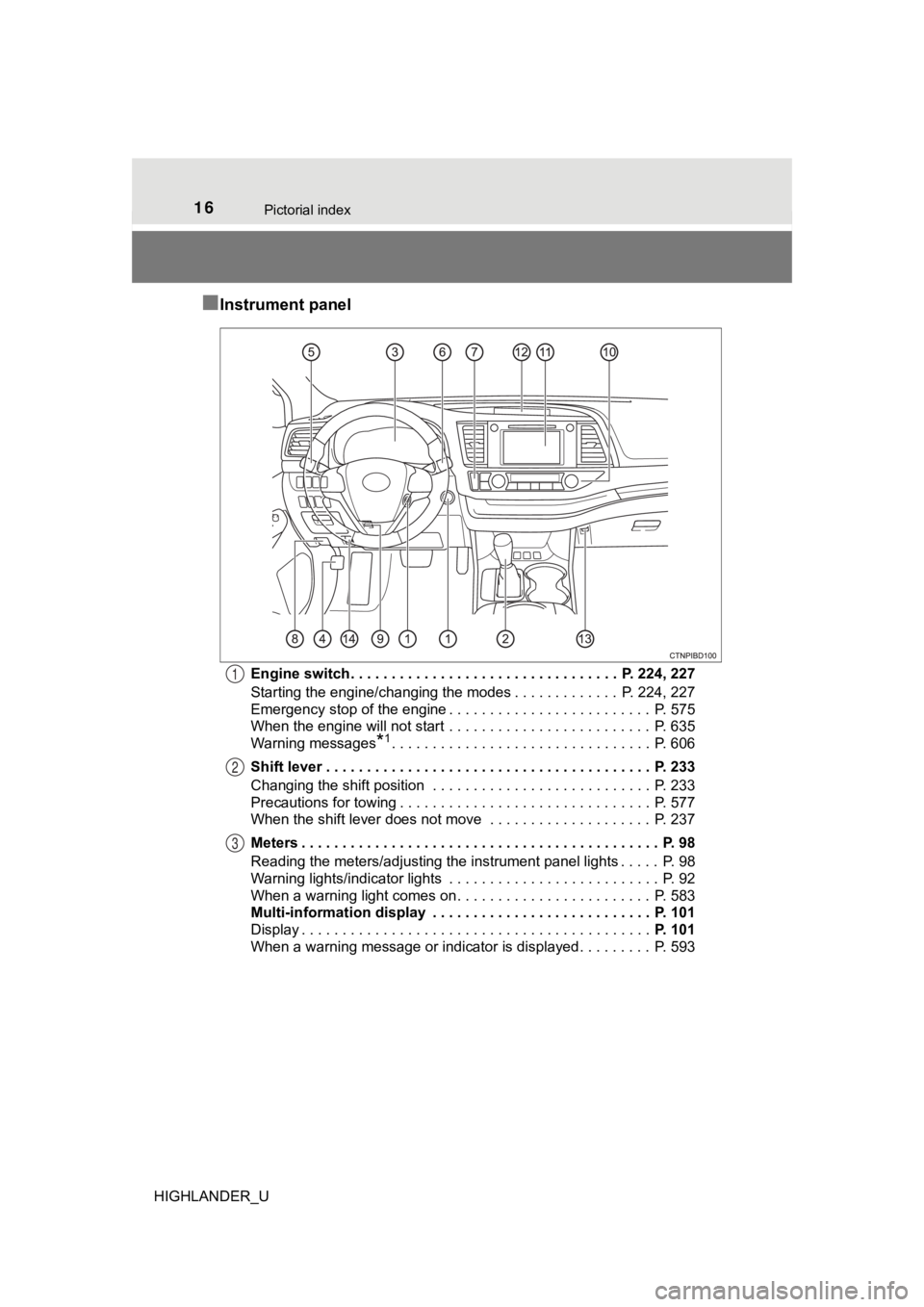
16Pictorial index
HIGHLANDER_U
■Instrument panel
Engine switch . . . . . . . . . . . . . . . . . . . . . . . . . . . . . . . . . P. 224, 227
Starting the engine/changing the modes . . . . . . . . . . . . . P. 224, 227
Emergency stop of the engine . . . . . . . . . . . . . . . . . . . . . . . . . P. 575
When the engine will not start . . . . . . . . . . . . . . . . . . . . . . . . . P. 635
Warning messages
*1. . . . . . . . . . . . . . . . . . . . . . . . . . . . . . . . P. 606
Shift lever . . . . . . . . . . . . . . . . . . . . . . . . . . . . . . . . . . . . . . . . P. 233
Changing the shift position . . . . . . . . . . . . . . . . . . . . . . . . . . . P. 233
Precautions for towing . . . . . . . . . . . . . . . . . . . . . . . . . . . . . . . P. 577
When the shift lever does not move . . . . . . . . . . . . . . . . . . . . P. 237
Meters . . . . . . . . . . . . . . . . . . . . . . . . . . . . . . . . . . . . . . . . . . . . P. 98
Reading the meters/adjusting the instrument panel lights . . . . . P. 98
Warning lights/indicator lights . . . . . . . . . . . . . . . . . . . . . . . . . . P. 92
When a warning light comes on . . . . . . . . . . . . . . . . . . . . . . . . P. 583
Multi-information display . . . . . . . . . . . . . . . . . . . . . . . . . . . P. 101
Display . . . . . . . . . . . . . . . . . . . . . . . . . . . . . . . . . . . . . . . . . . . P. 101
When a warning message or indicator is displayed . . . . . . . . . P. 593
1
2
3
Page 32 of 732
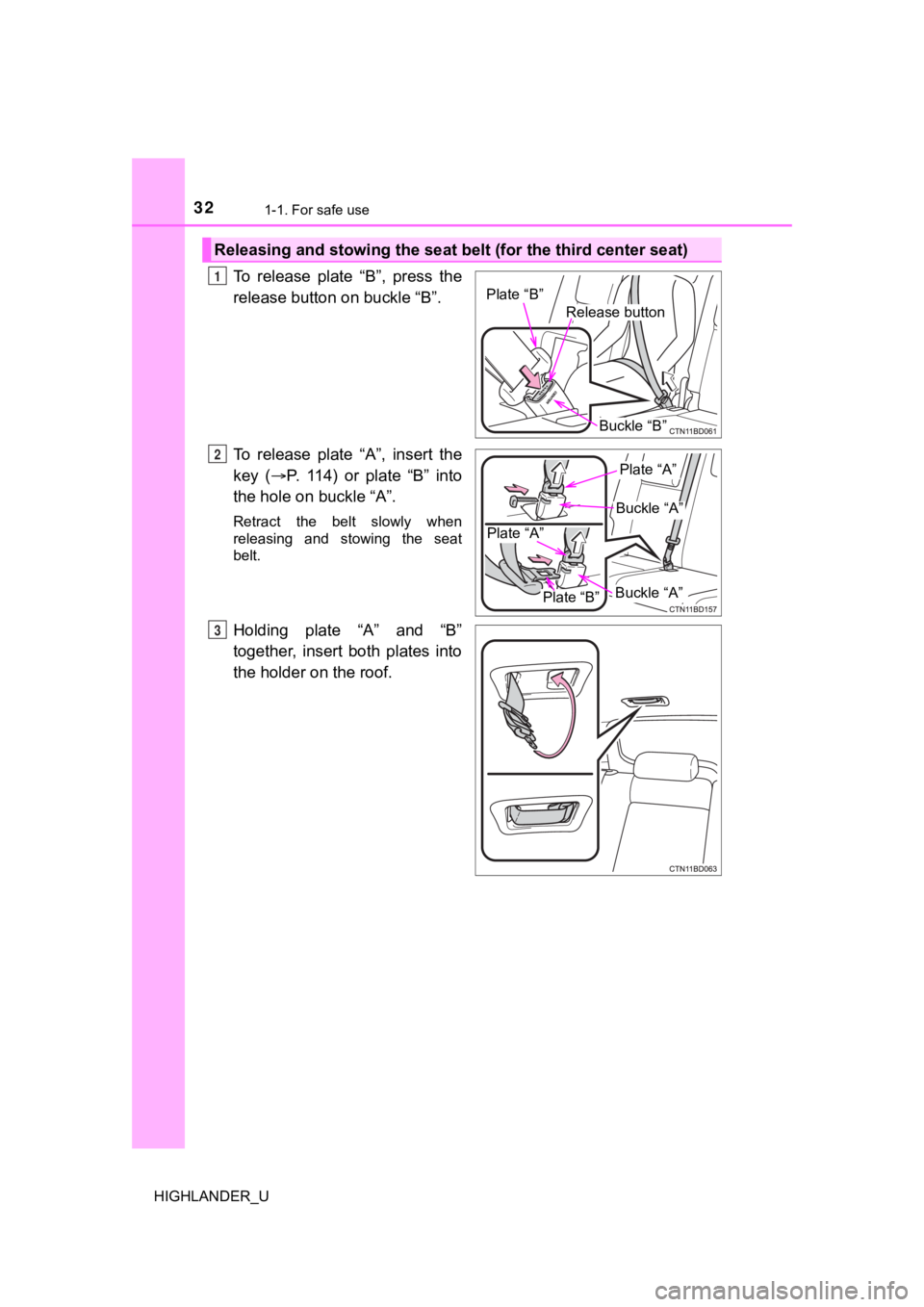
321-1. For safe use
HIGHLANDER_U
To release plate “B”, press the
release button on buckle “B”.
To release plate “A”, insert the
key ( P. 114) or plate “B” into
the hole on buckle “A”.
Retract the belt slowly when
releasing and stowing the seat
belt.
Holding plate “A” and “B”
together, insert both plates into
the holder on the roof.
Releasing and stowing the seat b elt (for the third center seat)
Release button
Plate “B”
Buckle “B”
1
Buckle “A”
Buckle “A”Plate “B”
Plate “A”
Plate “A”
O
P
Page 43 of 732

431-1. For safe use
1
For safety and security
HIGHLANDER_U
Your vehicle is equipped with ADVANCED AIRBAGS designed based
on the US motor vehicle safety standards (FMVSS208). The airbag
sensor assembly (ECU) controls airbag deployment based on infor-
mation obtained from the sensors etc. shown in the system compo -
nents diagram above. This informat ion includes crash severity and
occupant information. As the airbags deploy, a chemical reactio n in
the inflators quickly fills the airbags with non-toxic gas to h elp restrain
the motion of t he occupants.
WARNING
■SRS airbag precautions
Observe the following precautions regarding the SRS airbags.
Failure to do so may cause death or serious injury.
● The driver and all passengers in the vehicle must wear their se at belts
properly.
The SRS airbags are supplemental devices to be used with the se at belts.
● The SRS driver airbag deploys with considerable force, and can cause
death or serious injury especially if the driver is very close to the airbag.
The National Highway Traffic Safety Administration (NHTSA) advi ses:
Since the risk zone for the driver’s airbag is the first 2 - 3 in. (50 - 75 mm)
of inflation, placing yourself 10 in. (250 mm) from your driver airbag pro-
vides you with a clear margin of safety. This distance is measured from
the center of the steering wheel to your breastbone. If you sit less than 10
in. (250 mm) away now, you can change your driving position in several
ways:
• Move your seat to the rear as far as you can while still reach ing the ped-
als comfortably.
• Slightly recline the back of the seat.
Although vehicle designs vary, many drivers can achieve the 10 in. (250
mm) distance, even with the driver seat all the way forward, si mply by
reclining the back of the seat somewhat. If reclining the back of your
seat makes it hard to see the road, raise yourself by using a f irm, non-
slippery cushion, or raise the seat if your vehicle has that feature.
• If your steering wheel is adjustable, tilt it downward. This points the air-
bag toward your chest instead of your head and neck.
The seat should be adjusted as recommended by NHTSA above, whil e
still maintaining control of the foot pedals, steering wheel, and your view
of the instrument panel controls.
Page 45 of 732
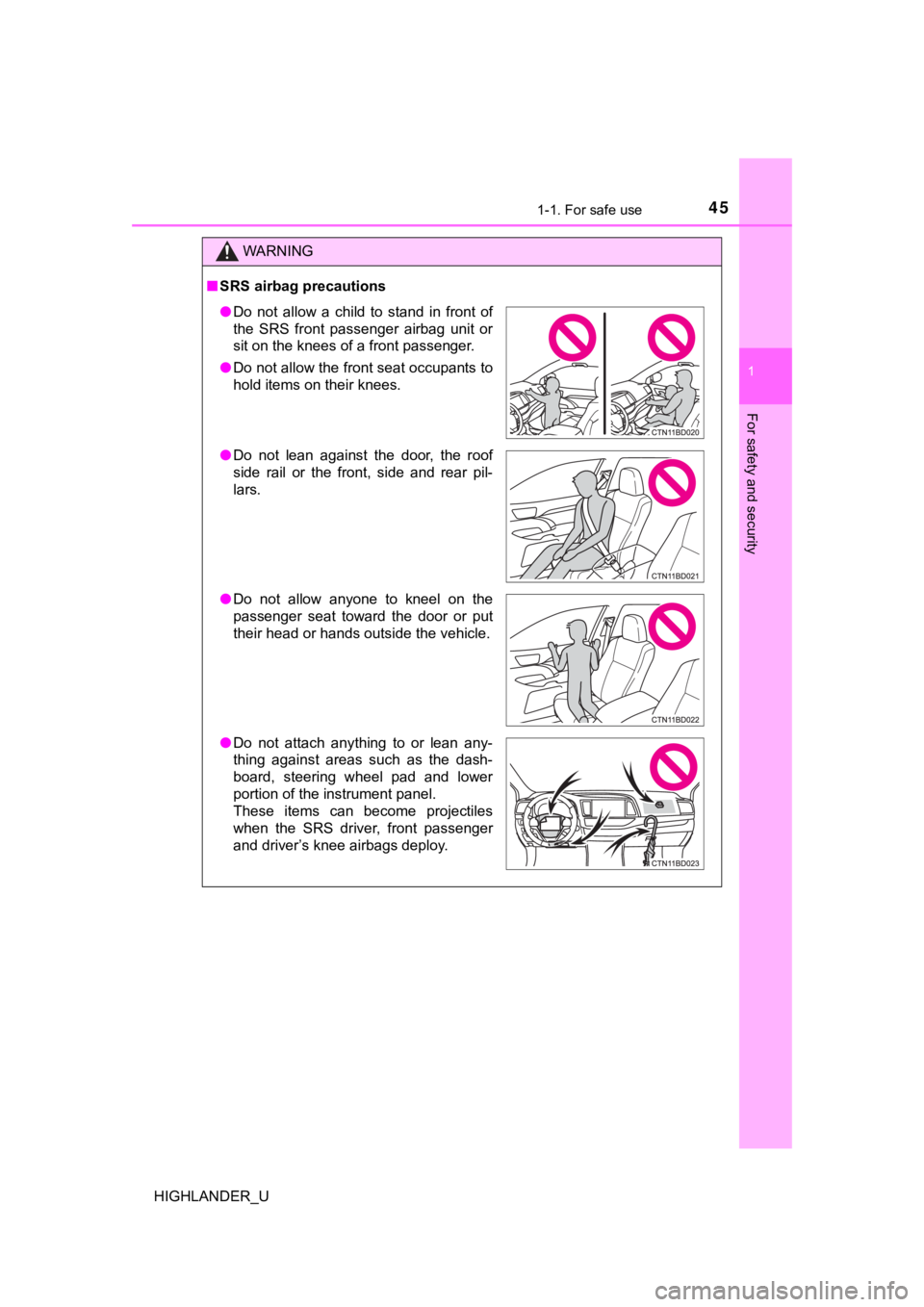
451-1. For safe use
1
For safety and security
HIGHLANDER_U
WARNING
■SRS airbag precautions
● Do not allow a child to stand in front of
the SRS front passenger airbag unit or
sit on the knees of a front passenger.
● Do not allow the front seat occupants to
hold items on their knees.
● Do not lean against the door, the roof
side rail or the front, side and rear pil-
lars.
● Do not allow anyone to kneel on the
passenger seat toward the door or put
their head or hands outside the vehicle.
● Do not attach anything to or lean any-
thing against areas such as the dash-
board, steering wheel pad and lower
portion of the instrument panel.
These items can become projectiles
when the SRS driver, front passenger
and driver’s knee airbags deploy.
Page 84 of 732

841-2. Emergency assistance
HIGHLANDER_U■
Emergency Assistance Button (“SOS”)
In the event of an emergency on t
he road, push the “SOS” button to
reach the Safety Connect respons e center. The answering agent
will determine your vehicle’s loca tion, assess the emergency, and
dispatch the necessary assistanc e required.
If you accidentally press the “SOS” button, tell the response-c enter
agent that you are not experiencing an emergency.
■
Enhanced Roadside Assistance
Enhanced Roadside As sistance adds GPS data to the already
included warranty-based Toyota roadside service.
Subscribers can press the “SOS” button to reach a Safety Connec t
response-center agent, who can he lp with a wide range of needs,
such as: towing, flat tire, fuel delivery, etc. For a description of the
Enhanced Roadside Assistance se rvices and their limitations,
please see the Safety Connect Te rms and Conditions, which are
available at Toyota.com in the United States, Toyotapr.com in
Puerto Rico and Toyota.ca in Canada.
Page 117 of 732

1173-1. Key information
3
Operation of each component
HIGHLANDER_U■
When required to leave the vehicle’s key with a parking attenda nt (vehi-
cles with a smart key system)
Lock the glove box as circumstances demand. (P. 467)
Remove the mechanical key for your own use and provide the attendant with
the electronic key only.
■ If you lose your keys
New genuine keys can be made by your Toyota dealer using the ot her key
(vehicles without a smart key system) or the other mechanical k ey (vehicles
with a smart key system) and the key number stamped on your key number
plate. Keep the plate in a safe place such as your wallet, not in the vehicle.
■ When riding in an aircraft
When bringing a key with wireless remote control function onto an aircraft,
make sure you do not press any buttons on the key while inside the aircraft
cabin. If you are carrying the key in your bag etc., ensure tha t the buttons are
not likely to be pressed accidentally. Pressing a button may cause the key to
emit radio waves that could interfere with the operation of the aircraft.
■ Conditions affecting operation
Vehicles without a smart key system
The wireless remote control function may not operate normally i n the follow-
ing situations:
● When the wireless key battery is depleted
● Near a TV tower, electric power plant, gas station, radio stati on, large dis-
play, airport or other facility that generates strong radio wav es or electrical
noise
● When carrying a portable radio, cellular phone or other wireles s communi-
cation device
● When multiple wireless keys are in the vicinity
● When the wireless key is in contact with, or is covered by a me tallic object
● When a wireless key (that emits radio waves) is being used near by
● When the wireless key has been left near an electrical applianc e such as a
personal computer
● If window tint with a metallic content or metallic objects are attached to the
rear window
Vehicles with a smart key system
P. 150
Page 150 of 732

1503-2. Opening, closing and locking the doors
HIGHLANDER_U■
Conditions affecting operation
The smart key system uses weak radio waves. In the following si tuations, the
communication between the electronic key and the vehicle may be affected,
preventing the smart key system, wireless remote control and en gine immobi-
lizer system from operating properly. (Ways of coping: P. 637)
● When the electronic key battery is depleted
● Near a TV tower, electric power plant, gas station, radio stati on, large dis-
play, airport or other facility that generates strong radio wav es or electrical
noise
● When carrying a portable radio, cellular phone, cordless phone or other
wireless communication device
● When the electronic key is in contact with, or is covered by the following
metallic objects
• Cards to which aluminum foil is attached
• Cigarette boxes that have aluminum foil inside
• Metallic wallets or bags
• Coins
• Hand warmers made of metal
• Media such as CDs and DVDs
● When other wireless keys (that emit radio waves) are being used nearby
● When carrying the electronic key together with the following devices that
emit radio waves
• Another vehicle’s electronic key or a wireless key that emits radio waves
• Personal computers or personal digital assistants (PDAs)
• Digital audio players
• Portable game systems
● If window tint with a metallic content or metallic objects are attached to the
rear window
● When the electronic key is placed near a battery charger or ele ctronic
devices
Page 159 of 732
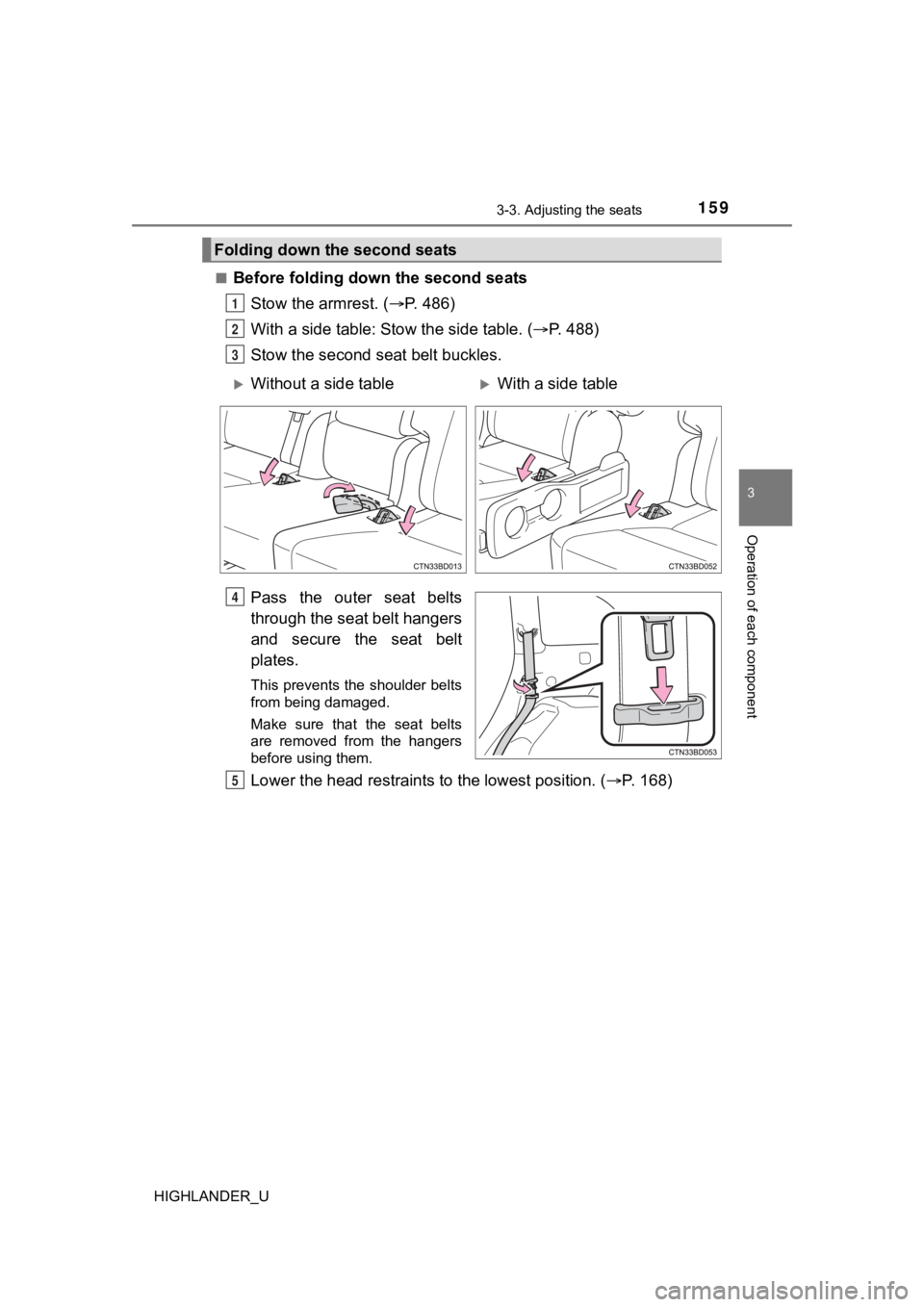
1593-3. Adjusting the seats
3
Operation of each component
HIGHLANDER_U■
Before folding dow
n the second seats
Stow the armrest. ( P. 486)
With a side table: Stow the side table. ( P. 488)
Stow the second seat belt buckles.
Pass the outer seat belts
through the seat belt hangers
and secure the seat belt
plates.
This prevents the shoulder belts
from being damaged.
Make sure that the seat belts
are removed from the hangers
before using them.
Lower the head restraints to the lowest position. ( P. 168)
Folding down the second seats
1
2
3
Without a side tableWith a side table
4
5